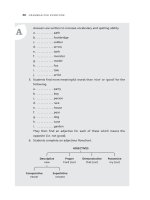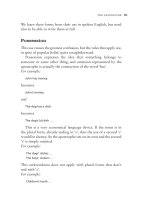Grammar for everyone part 16
Bạn đang xem bản rút gọn của tài liệu. Xem và tải ngay bản đầy đủ của tài liệu tại đây (174.12 KB, 7 trang )
C
Checklist: subject and predicate
The student should now be able to:
• explain the term subject
• explain the term predicate
• correctly divide sentences into subject and predicate
• parse single sentences unaided
• recognise omitted subjects, understood as in commands – (You) go
to bed. Don’t (you) forget your lunch
Abbreviations
If the students are showing confidence in diagramming sentences
and recognising the parts of speech, it is now appropriate for them
to start using abbreviations, in order to save time and space. At
this point too, articles may be included with their nouns unless
otherwise requested.
95
s u b j e c t A n d p r e d i c At e
Tomorrow you must wash the car.
The following abbreviations are commonly used in dictionaries,
but need to be used accurately to avoid confusion. Lower case is
used.
Word Abbreviated Word Abbreviated
noun n preposition prep
verb vb conjunction conj
pronoun pron interjection interj
adjective adj exclamation excl
adverb adv subject subj
article art predicate pred
96
G r A M M A r f o r e V e rY o n e
Objects – direct and indirect
Definition: The word ‘object’ is from Latin ob meaning ‘against’
or ‘at’, and ject meaning ‘thrown’.
Before studying objects, students should:
• understand the function of verbs
• know past, present and future tenses, both simple and
continuous
• recognise the subject wherever it comes in a sentence
The concept of the direct object is very straightforward. That
of the indirect object is also, provided it is taught in sequence and
well explained in examples. Although these terms may at first seem
relevant only to the grammar lesson, their importance becomes
more obvious when we are giving instruction about correct speech.
Once you, too, become confident with the terms, you are em-
powered to guide and coach in debate and public speaking, as well
as in good written English. So ensure that students fully understand
the term direct object before you introduce the indirect object.
The direct object
The idea is that the object is that which the action is directed at;
hence the term ‘direct’. In simple terms, the object completes the
action of the verb. If you can ask ‘What?’ after the verb, then the
answer is the direct object.
For example:
My sister cooked pancakes.
The question: She cooked what?
The answer: pancakes
15
97
A
98
G r A M M A r f o r e V e rY o n e
My sister cooked pancakes.
Therefore, pancakes is the object of the verb ‘cooked’ in this
sentence.
A noun or pronoun following a preposition is called its object.
For example:
It flew through the air.
The air is the object of the preposition ‘through’.
15.1 Activities: direct objects
1. Students take turns asking what? questions. They could randomly
call on another student to answer, for example:
First student: What did you have for breakfast?
2nd person: Baked beans.
The answer is the direct object. One or two of these could be entered
into students’ grammar exercise books.
A
2. Sentences can be provided for students to complete by adding a
direct object, for example:
The Prime Minister gave [what?] – [a speech]
a. We all had . . . . . . . . . . (lunch)
b. John’s father drives . . . . . . . . . . (a truck)
c. I bought . . . . . . . . . . (a dog-collar)
d. My brother plays . . . . . . . . . . (a clarinet)
e. Dad grew . . . . . . . . . . (big onions)
f. Don’t forget to take . . . . . . . . . . (an umbrella)
g. Just fill in . . . . . . . . . . (this form)
h. Let’s book . . . . . . . . . . (seats)
i. They forgot their . . . . . . . . . . (togs)
3. Students underline the subject and circle the object in these
sentences.
a. Please will
you buy some muffins ?
b. Don’t you love motor racing?
c. We all planted fruit trees.
d. The kookaburra ate a poisonous snake.
e. They let off a hundred coloured balloons.
f. Tell us a story!
g. We may have to sing a song.
h. Can you tow the wreck home?
i. All day I have been practising tai chi.
j. That puppy chewed up Dad’s slippers.
4. a. Provide students with a list of suitable words from which they
make sentences, choosing a subject and a verb from the list, for
example:
hammer, Olivia, my cake, a mess, tea-tray, old socks, the
blacksmith, toast, the sparrows, an old man.
b. Students could circle the direct object in each of the sentences
they have written and underline the verb that governs it.
99
o b j e c t s – d i r e c t A n d i n d i r e c t









